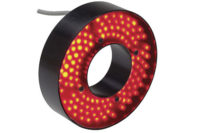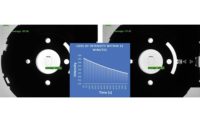
When machine operators are polled about the most challenging aspect of applying vision systems, the overwhelming majority have a single word answer: lighting. What makes lighting such a critical component when applying a vision sensor?
The heart of a machine vision application is light. Essentially an image processor, the digital imager used in both machine vision and consumer digital cameras is a light collector. Each tiny imager component, picture element or pixel is a microscopic light measurement sensor.
Each pixel’s light level-in the 300,000 to 5 million pixels typically present in a machine vision system-is processed in a machine vision algorithm. The only other pixel data is its X-Y address-its location-on the image processor grid.
Unless light-both applied light and ambient light noise-are controlled, it is essentially impossible for a vision system to perform reliably.

Best Practices
Light is the most critical tool for creating adequate contrast for a successful and reliable machine vision application.
Quite simply, contrast is the delta between the light levels on the feature of interest and every other feature visible to the imager. The total scope of the area seen by the imager, or field of view, is divided between the feature of interest and the background of these features.
Illumination, or lumen levels, from the feature of interest are differentiated from all other elements of a field of view. In the case of front lighting-lighting from the top-the lumen level on features of interest is maximized. In the case of backlighting, the light level is minimized or completely blocked.
Choices for lights to create and amplify contrast are nearly infinite. Lights are available in differing photon producers, such as halogen, incandescent, light-emitting diode (LED), and also differing shapes-spot, area blocks-or evenly illuminated backlights, for example, linear, diffused, reflective domes, coaxial, and all in differing colors or wavelengths. To cut through the cacophony of options, the best advice is to backlight the application, if possible.
Backlighting entails placing a light opposite the smart camera to maximize contrast. This results in creating a silhouette. Opaque objects are dark, whereas more translucent or empty air spaces in the rest of the field of view are contrastingly bright. This is the most ideal method of applying machine vision for opaque object presence, shape and measurement.
When backlighting a part for gaging it becomes critical to collimate the backlight as it shines on the part, silhouetting the part from the camera. Incoherent light will wrap around the silhouetted part, distorting its measurement.
Collimation can be achieved with a collimating filter on the surface of the light, or more simply by increasing the distance between the light, the part and the camera.
When deploying either method, its cost is less lumens from the light shining on the camera and being blocked by the part, lessening contrast. However, the contrast from this method has such a significant margin that the light loss from increasing the distance of or filtering the backlight greatly benefits both the accuracy and repeatability of the measurement without compromising required contrast.
Often backlighting is not feasible because the mechanical space to fit the part between the camera and light is unavailable, or the feature of interest is on the surface of an opaque background. Then the art of optimal lighting for creating contrast becomes more complex.
Significant arrays of lighting options become available for surface lighting an object. To build adequate lighting with top or low angle surface lighting requires experimentation-often very time-consuming trials-with the part, the camera and various lighting options. Shortening this time-extensive experimentation is to see if a ring light surrounding or an area light closely adjacent to the camera creates adequate contrast levels. The simplest way of selecting front or dark angle lights is to contract a professional vision integrator.
After the lighting method is determined, a critical practice is to make the controlled light used to create contrast in the application free of light noise from ambient factory light.
The best ways to eliminate ambient light from affecting robust contrast include:
Smarter Vision Algorithms
Sometimes, light-engineered contrast seems too minimal for an application to succeed. Contrast, even with optimal lighting, is imperfect and not perfectly consistent. This is where smart camera image pre-processing tools come into play.Software delivers scores of tools for extrapolating better contrast. Sophisticated image filtering algorithms, such as edge enhancement, Gaussian, meridian, average and binary filtering, light leveling, morphing and erosion controls, maximizes contrast for marginal contrast images.
Image geometry tools use image sampling, line-profiling and other algorithms to further interpolate data from images with less-than-ideal contrast.
Lighting is the first tool for building a stable contrast foundation for vision systems. Image filtering and geometry are the next steps for robust contrast and reliable vision sensing.
Controlled light creates contrast. Maximized contrast is a requirement for all successful vision system applications. The brighter LEDs continually being developed make contrast control better and better.
Tech Tips
- Light is the most critical tool for creating adequate contrast for a successful and reliable machine vision application.
- When backlighting for gaging a part, it becomes critical to collimate the backlight as it shines on the part, silhouetting the part from the camera.
- Maximized contrast is a requirement for all successful vision system applications.



